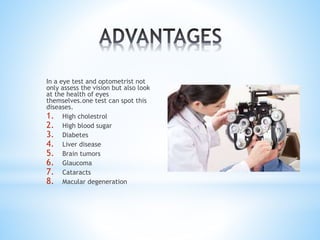The Function of Advanced Diagnostic Tools in Identifying Eye Disorders
In the world of ophthalmology, the use of sophisticated diagnostic devices has reinvented the very early identification and monitoring of different eye disorders. As the demand for specific and timely medical diagnoses continues to grow, the assimilation of cutting-edge devices like optical coherence tomography and aesthetic area testing has actually become important in the world of eye treatment.
Significance of Very Early Diagnosis
Early diagnosis plays a pivotal duty in the reliable monitoring and treatment of eye conditions. Timely recognition of eye problems is important as it permits prompt treatment, possibly protecting against more development of the condition and decreasing long-term issues. By finding eye conditions at a beginning, doctor can offer suitable therapy strategies tailored to the details condition, eventually bring about better end results for individuals. Early medical diagnosis allows patients to accessibility needed assistance services and sources earlier, boosting their overall high quality of life.

Modern Technology for Spotting Glaucoma
Innovative diagnostic modern technologies play an essential role in the very early discovery and surveillance of glaucoma, a leading reason of permanent blindness worldwide. An additional innovative tool is aesthetic field testing, which maps the level of sensitivity of an individual's visual area, aiding to spot any locations of vision loss characteristic of glaucoma. These innovative analysis devices make it possible for eye doctors to diagnose glaucoma in its early phases, enabling for timely treatment and much better monitoring of the disease to prevent vision loss.
Role of Optical Coherence Tomography

OCT's capacity to quantify retinal nerve fiber layer density enables specific and objective measurements, aiding in the early detection of glaucoma also before aesthetic field issues emerge. Moreover, OCT innovation permits longitudinal monitoring of architectural adjustments in time, promoting individualized therapy plans and timely treatments to help maintain clients' vision. The non-invasive nature of OCT imaging additionally makes it a recommended selection for monitoring glaucoma progression, as it can be duplicated regularly without causing discomfort to the person. In general, OCT plays a critical her response duty in enhancing the diagnostic precision and monitoring of glaucoma, eventually adding to far better outcomes for individuals in danger of vision loss.
Enhancing Medical Diagnosis With Visual Field Screening
A crucial part in detailed sensory assessments, aesthetic field screening plays a critical role in enhancing the analysis procedure for numerous eye problems. By evaluating the full degree of a client's aesthetic field, this examination gives vital information about the useful stability of the entire visual pathway, from the retina to the visual cortex.
Visual area testing is her comment is here especially important in the medical diagnosis and administration use this link of problems such as glaucoma, optic nerve problems, and numerous neurological diseases that can impact vision. With measurable measurements of peripheral and main vision, medical professionals can find subtle changes that may suggest the existence or progression of these disorders, also prior to obvious signs happen.
In addition, aesthetic field testing permits the surveillance of therapy efficiency, assisting ophthalmologists tailor healing treatments to private clients. eyecare near me. By tracking modifications in visual field performance with time, medical care suppliers can make enlightened choices regarding changing medications, recommending medical interventions, or carrying out various other ideal steps to protect or boost a patient's aesthetic feature
Taking Care Of Macular Deterioration

Verdict
In final thought, progressed diagnostic tools play a crucial role in identifying eye conditions early on. Technologies such as Optical Coherence Tomography and aesthetic area screening have substantially enhanced the precision and performance of diagnosing conditions like glaucoma and macular degeneration.